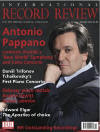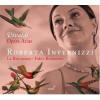Texte paru dans: / Appeared in:
*

International Record Review - (10/2012)
Pour
s'abonner / Subscription information
Glossa
GCD922901

8424562229013 (ID237)
Consultez toutes les évaluations recensées pour ce cd
~~~~ Reach all the evaluations located for this CD
Giuseppe Tartini famously disparaged Vivaldi as treating singers’ voices like the necks of violins. As this disc demonstrates, Vivaldi was in fact a superb opera composer. This should come as no surprise, for his success as a composer of concertos owed much to the sheer ‘vocal’ or operatic quality of his solo parts, full of inventive themes, melodies and harmonic contrasts, and his uncanny ability to evoke an affect or mood. Thus, Vivaldi’s style translates easily into opera, even if he demands a lot from his singers. No better example is the second aria in the Milanese soprano Roberta Invernizzi’s and La Risonanza’s programme, the tearful ‘Leggi almeno, tiranna infedele’ from Ottone in villa (the 35-year-old Vivaldi’ s first opera) : with its vocal part floating melodiously over a pulsing string accompaniment, it could easily stand in for the slow movement of a violin concerto.
Confirming the noble Abbé Antonio Conti’s often-quoted opinion that Vivaldi’s opera arias were ‘varied both in their sublime and tender passages’, the fecundity of Vivaldi’ s musical imagination in this succession of arias, while never breaking out of the Vivaldian stylistic mould, is breathtaking. Invernizzi and La Risonanza’s harpsichordist director , Fabio Bonizzoni, have made their selections (about half of them from two of Vivaldi’s richest operas, Tito Manlio and Ottone in Villa) with an eye to diversity. Their arias express, among other emotions, noble resolve, rage, turmoil, betrayal tearful supplication , lovelorn lamentation and simple pastoral tenderness.
As an example of the composer’s dramatic skill, the coloratura-filled jealousy aria ‘Gelosia’ from Ottone in villa switches surprisingly but very effectively to a grief-laden largo halfway through, expressing the other facet of that tumultuous emotion. Besides a simple string orchestra or just basso continuo to accompany the voice, there are arias with an obbligato instrument as well (including a martial trumpet in the disc’s first aria, ‘Combatta un gentil cor’ , a sweet violin in the fourth, ‘Non ti lusinghi la crudeltade’ , and a tangy viola d’amore in the eleventh, ‘Tu dormi in tante pene’ , all from Tito Manlio, which Vivaldi wrote for the sumptuous Mantuan court) . Vivaldi always also places heavy demands on the singer, with flamboyant passagework, curling flourishes of coloratura and, in the sad or tender arias, long flowing melodic lines.
Sadly, the promise of this recital is undermined by the performance. This disc is heavily marketed as a showpiece for the voice and dramatic skills of Invernizzi, who has made a career in historically informed performance of Baroque vocal music. There was a time when, being possessed of an attractively brilliant and agile voice, Invernizzi was a reasonably fine interpreter of Baroque opera. Today, however, her voice, though still pretty (albeit with a slightly whining quality) and very supple , is swathed in a heavy, pitch-distorting vibrato, which she either does not wish to restrain or no longer can. Readers who are not convinced, or disagree with the theory that Baroque opera requires singers with minimal vibrato, should listen for example to the tender ‘Se garrisce la rondinehla’ (Orlando finto pazzo), in which Invernizzi’s rendition of Vivaldi’s beautiful soprano line, unlike the sympathetic solo violin, dissolves at times into a confusing tremolo, or ‘Fra le procelle del mar turbato’ (Tito Manlio) , in which Invernizzi has difficulty with the lyrical passages following her impressive account of its very athletic coloratura.
Stylistically, there is little difference between the arias for castrato (nine of the 14 in the programme: Lucio in Tito Manlio, Ciao in Ottone in villa, Fihindo in Dorilla in Tempe, Morasto in Lafida ninfa, Cesare in Catone in Utica and Ottone in Griselda) and those for female soprano (Ippolita in Ercole sul Termodonte, Ersilla in Orlando finto pazzo, Costanza in Griselda, Leocasta in Il Giustino and Servilia in Tito Manlio). The more robust of the castrato arias perhaps display a greater fieriness than the female ones. Maybe it is unfair to wish Invernizzi had sought to distinguish castrato and female soprano arias, since this is, after all, a recital disc rather than a dramatic performance ; but even in the martial opening aria for castrato her sound is extremely feminine and, thanks to the excessive vibrato , often rather old-maidish.
La Risonanza, on the other hand, is irreproachable. Under Bonizzoni’s expert direction, its soloists, alert strings and inventive continuo team of cello, double bass, harpsichord and, by turns, a very attractive archlute and theorbo provide Invernizzi with an unfailingly sensitive support. However, neither the wonderful music nor La Risonanza can raise this disc to an acceptable standard.
Cliquez l'un ou l'autre
bouton pour découvrir bien d'autres critiques de CD
Click either button for many other reviews


